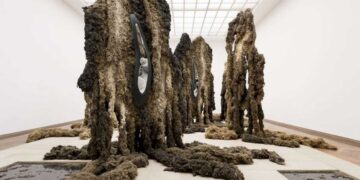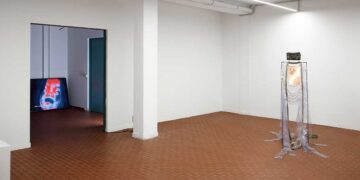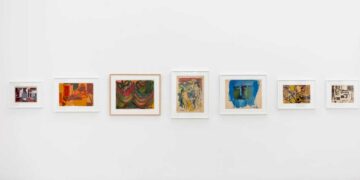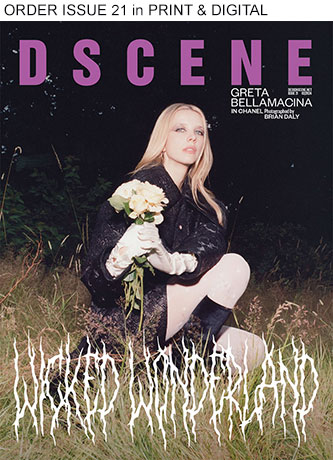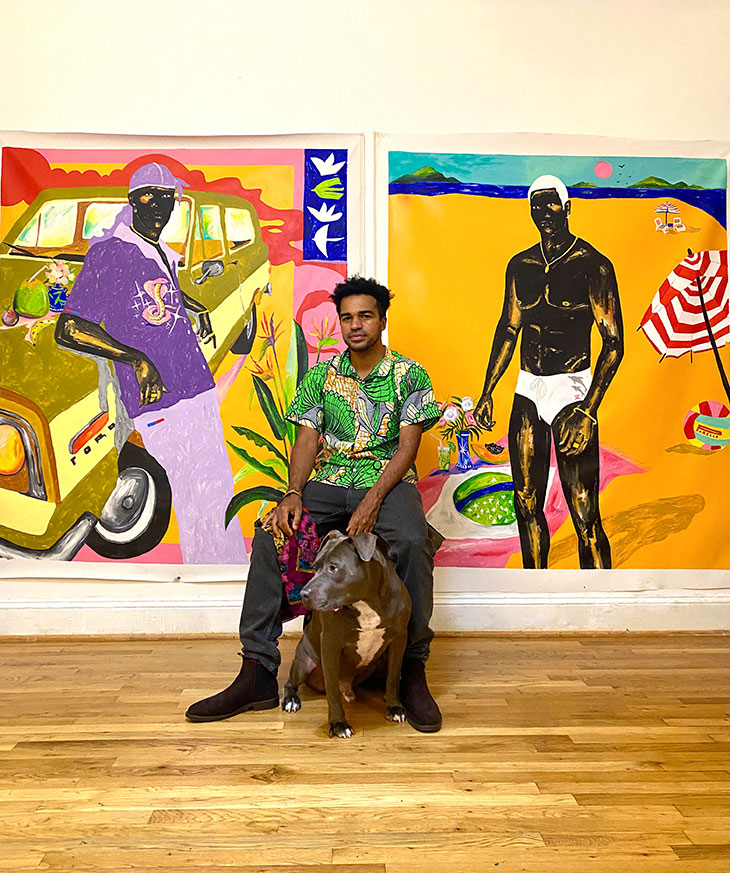
Brazilian artist Zéh Palito aims to establish a harmonious connection between humanity and the environment, drawing inspiration from a diverse range of cultural influences including Brazilian, African, and American traditions. The artist’s oeuvre spans a wide range of scales, from grandiose site-specific murals to intimate figurative pieces on canvas. His dedication to environmentalism is mirrored in his work’s emphasis on uplifting and honoring marginalized communities and voices that have been historically overlooked.
ART
DSCENE Magazine’s Features Director Katarina Doric sits down with Zéh to talk about representation, challenging the stereotypes, as well as his upcoming exhibition at Luce Gallery New York City.

What sparked your interest in art? – When I was 15 years old I used to like skateboarding and soccer, but I got a knee injury, so I could not do those sports anymore. I remember being sad about it during that time. So my mother put me in an art class. Which was the one thing that I loved to do the most growing up.
My first art memories are from my childhood enjoying comic books and as a teenager doing graffiti in Brazil. What kept my interest in art alive was the necessity to always express myself and share a message. I guess when I was a kid I shared this message and expressed myself through the drawings, as a teenager with the graffiti on the walls, and now with my canvas.
Your artistic practice started with larger-than-life murals in the streets of Sao Paulo. How did you decide to switch from wall to canvas? – I always liked to work on canvas and walls. But these past 3 years I have focused more on canvas, but I am still doing murals from time to time. I think switching from walls and huge surfaces to canvas was just an evolution of me as an Artist. The more I painted, the more I wanted to diversify my mediums. Painting on a smaller scale also became a lot easier. When I am painting outside, I have to deal with things I can’t control like the weather, people, and other external issues. Painting canvases, I have the ability to think about the deeper meanings of my paintings and can play with different themes and compositions, incorporating new elements into each piece that I might not have been able to include prior. Doing murals I would mainly freestyle on the surfaces I painted. Now, I spend more time planning and thinking about what I will do next because I can see my entire canvas and map out my vision.

Your work is known for using vivid colors, loose brushwork, and dynamic imagery. Tell us more about your visual style. How did it evolve? – Color is a big part of my work and I believe it can be used to create and express so many different emotions. I’d like to think that my work just flows. There’s an “unfinished” quality about the paintings that create this open-ended experience for the viewer. As I am from Brazil, the colors that I use are always vibrant and it has a tropical vibe. But my work also has a big visual influence on African and African American culture. During the past years, I spend a lot of time traveling to USA and traveling to different countries in Africa, this has definitely influenced and evolved my art.
I want to challenge the stereotypes we’re often placed in and the settings we’re seen in. Instead of focusing on our traumas, I want to show the black experience in love, leisure, happiness, and confidence. For once, I want these black bodies to be the protagonists of their own stories.
The title of your new show “Won’t You Celebrate with Me” is inspired by Lucille Clifton’s poem of the same name. What is the connection between her poetry and your art? – Lucille spent her life in Baltimore, which is where I split my time between Baltimore and Brazil. I first read this poem by Lucille about 3-4 years ago, and it inspired a painting I actually created last year called, “Won’t you celebrate with me,” which became my first piece at the Baltimore Museum as well. As I started to think about this exhibition coming up, I went back to all the documents and text from Lucille and was reminded of how beautiful it was. This poem translates to the exhibition very well as it is an invitation, a warm gesture welcoming you to celebrate with me. There is a line from the poem that I love which says, “Come celebrate with me, that every day something has tried to kill me and has failed.” That inspired me to build a show that could capture the leisure and resilience within the black experience.

Through your work, you offer a nuanced and multifaceted portrayal of the diverse realities experienced by Black individuals. What is the message? – The idea of representation is really interesting to me and how we reference culture and history through paintings. There will always be great artists who showcase black trauma and pain, and I think that is still very important. But I want to normalize the presence of black bodies in art that sits in museums, institutions, and galleries. I want to challenge the stereotypes we’re often placed in and the settings we’re seen in. Instead of focusing on our traumas, I want to show the black experience in love, leisure, happiness, and confidence. For once, I want these black bodies to be the protagonists of their own stories.

Your work exudes a sense of optimism despite the gravity of the subject matter. Are you optimistic about the direction the world is heading in? – I am an optimist at heart and I’m really glad this is recognized in my work by audiences. My paintings show lovely, simple, leisurely moments, people enjoying themselves in their free time and all the simple things in life. I’ve lived in Brazil, the US, and Africa and even though we carry the same traumas and skin tones with similar narratives, I’ve come to understand that the experience of being Black in Brazil, Black in the United States, and Black in Africa is similar but also different. These different experiences along with the significant lack of representation in art history prove the importance of telling black stories rooted in facts. But what I paint is also real – real moments shared, inspired by real figures in my own life. I hope that seeing happier moments on canvas will inspire people to reflect on their own surroundings and celebrate themselves as well, no matter where they come from.
As black people, no matter what part of the world we live in, we’ve often been made to feel like our struggle is a badge of honor. The tougher our skin and the harder life is, that “proves” how strong we are. I want to challenge that narrative with my work and allow people to see that there is also strength in leisure.
Your subjects are often portrayed in a state of leisure, enjoying the simple pleasures of life. Is leisure a necessity, as Fred Moten states? – Leisure needs to be celebrated and enjoyed more. I come from Brazil where the lifestyle is pretty much based on Family and Leisure. I live in the country, on a farm, so the pace is a bit slower and more quiet. Having this state of peace constantly inspires me and gives me the space to be as creative as I want. As black people, no matter what part of the world we live in, we’ve often been made to feel like our struggle is a badge of honor. The tougher our skin and the harder life is, that “proves” how strong we are. I want to challenge that narrative with my work and allow people to see that there is also strength in leisure. As Lucille says in her poem, “…Every day something has tried to kill me, and has failed.” I hope people take a moment to celebrate that they’ve made it through another day.

How do you think new digital and virtual mediums will affect the future evolution of figuration? – I think artists and the art space will always continue to evolve and advance, but that will never change the way I create my own work. Because most of my paintings come to me in the form of a dream, there is no technology that will be able to create those visions better than my own two hands and human creativity.
Are there any artists from the present or past who particularly resonate with you? – My favorite artists from present and past are Paul Gauguin, Tarsila do Amaral, Kerry James Marshall, Matisse, David Hockney, Mickalene Thomas, Derrick Adams, Katherine Bernhardt, Amoako Boafo, Jadé Fadojutimi, Claire Tabouret, Adriana Varejão, Emanoel Araújo a few to mention.

Who are your heroes in real life? – My mother and my father. The strongest and sweetest heroes that I know it.
What’s next for you? – I’m really enjoying my life just painting and taking it each day at a time. I want to keep making works that exude hope and love because I think it’s crucial that part of the black experience is not forgotten. I don’t know where my life will take me next, but I’m happy with the path that I’m on now.
Zéh Palito’s first NYC solo exhibition, curated by Larry Ossei-Mensah, at Luce Gallery New York City residence is opening Friday, May 19.
Keep up with Zéh Palito on Instagram – @zehpalito















